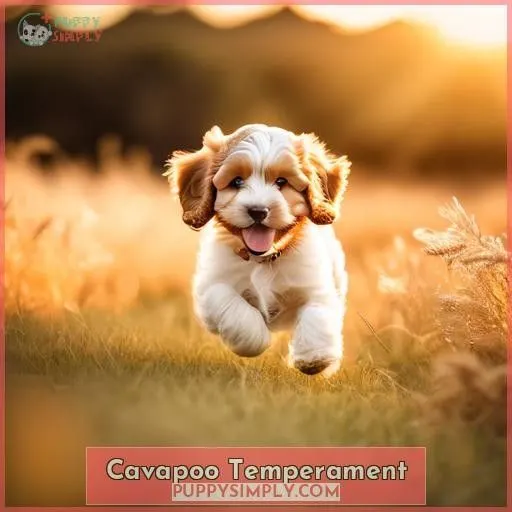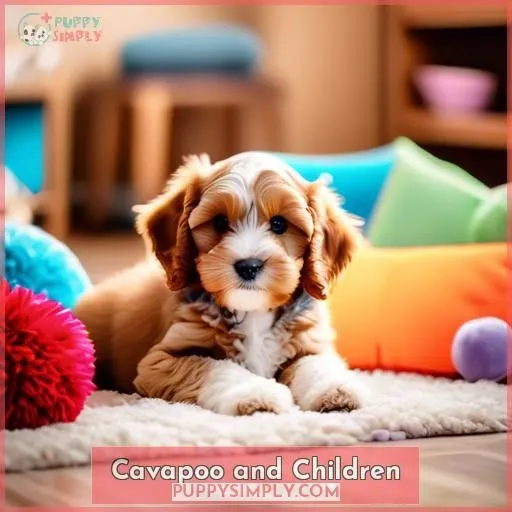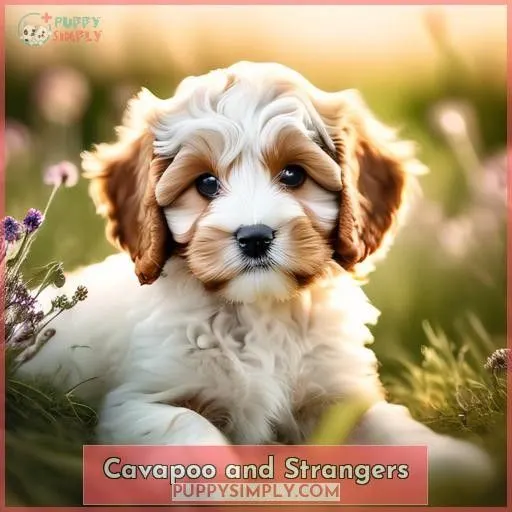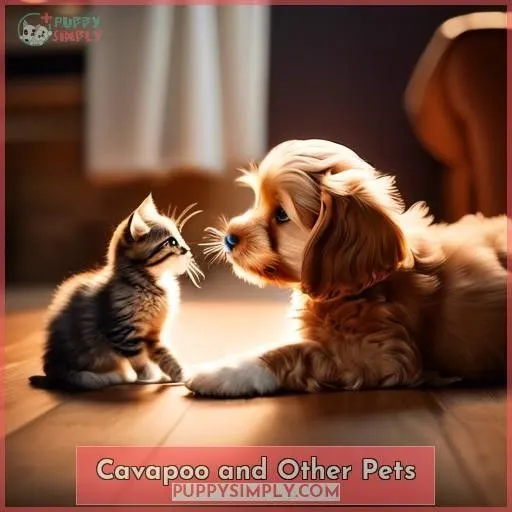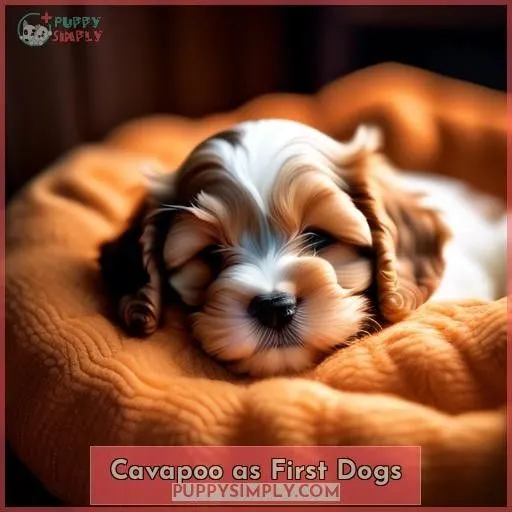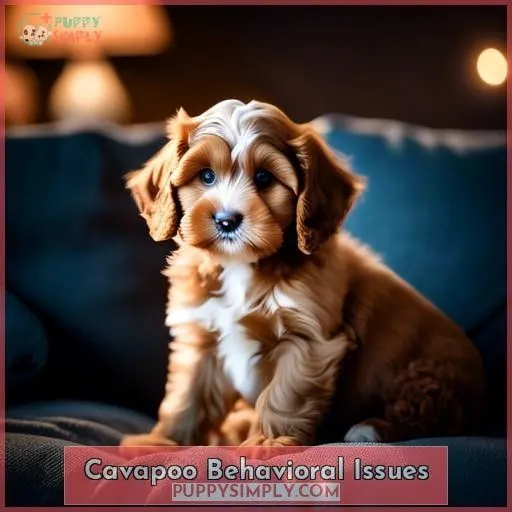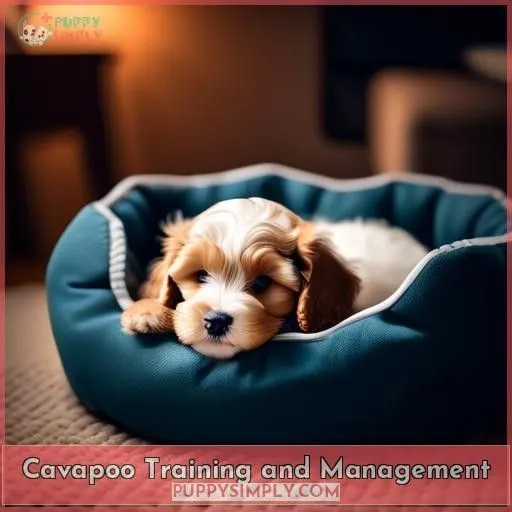This site is supported by our readers. We may earn a commission, at no cost to you, if you purchase through links.

You’ll notice your Cavapoo’s boundless energy starts to mellow around 18-24 months old.
Until then, you’ll need patience and consistency in training to help them calm down.
While they’re affectionate companions, Cavapoos thrive with early socialization and positive reinforcement methods.
Don’t worry, their enthusiasm becomes more manageable as they mature into well-adjusted adults.
If you’re still struggling to tame those puppy antics, learning proper techniques can transform that overexcited pup into the perfect furry friend.
Table Of Contents
Key Takeaways
- Cavapoos typically calm down around 18-24 months old, but patience and consistent training are necessary before then.
- Early socialization and positive reinforcement methods are crucial for Cavapoos’ development into well-adjusted adults.
- Cavapoos are known for their friendly and sociable nature, making them suitable for families with children of various ages.
- Proper training and management strategies can address potential behavioral challenges in Cavapoos, such as resource guarding and aggression.
When Do Cavapoos Calm Down?
Cavapoos typically start to calm down around one to two years of age, after the puppyhood period. However, some Cavapoos may begin to mellow out earlier, around six months of age. During the adolescence phase, which lasts from six to eighteen months, Cavapoos can be particularly challenging as they go through various developmental stages.
Cavapoo Temperament
Welcome to the realm of Cavapoos! These charming dogs are renowned for their amiable, sociable demeanor and their aspiration to gratify their owners. They’re an exceptional selection for families with progeny of diverse ages, as they exhibit gentleness and affection towards toddlers and exuberance and vitality for elder children. Notwithstanding, it’s imperative to bear in mind that akin to all breeds, Cavapoos necessitate socialization and oversight to guarantee their maturation into well-balanced, contented canines.
Regarding grooming, Cavapoos are classified as low-shedding, yet they still require routine brushing to forestall matting and tangling. The texture of their coats may differ, with some possessing curly locks that demand greater attention. Bathing should be conducted with a shampoo designated for canines, and professional grooming appointments are advisable every 6-8 weeks to sustain the health and aesthetics of their coats.
Cavapoos are also celebrated for their astuteness, rendering them swift learners. This attribute makes them ideal for novice owners, as they’re enthusiastic about pleasing and respond favorably to training methods based on rewards. They’re also suitable candidates for therapy dogs due to their tranquil temperament and proficient social abilities.
However, Cavapoos may be susceptible to behavioral challenges, such as guarding resources and aggression. These issues can be addressed with appropriate training and management strategies, such as steering clear of confrontation and providing more desirable alternatives. It’s also crucial to establish a secure sanctuary for your Cavapoo and seek professional assistance from a qualified trainer or behaviorist as required.
Cavapoo and Children
Shifting from the overall nature of Cavapoos, let’s focus on their relationship with children.
These adorable creatures are adored by toddlers, showering them with gentle love.
For older children, a Cavapoo’s playful spirit perfectly complements their endless energy.
However, the key to a well-behaved dog around your little ones is a sprinkle of socialization and a dash of training during those essential puppy developmental phases.
Engaging in nose work can be a game-changer in calming down those spirited Cavapoo puppies.
Cavapoo and Strangers
As a Cavapoo parent, you’re likely pondering when your furry companion will commence to tranquilize and adapt to a more tractable level of energy. The auspicious news is that Cavapoos generally initiate to relinquish their exuberant traits around the age of two years old, albeit this can fluctuate from dog to dog. Notwithstanding, even upon attaining adulthood, certain Cavapoos may persist in being readily excitable and manifest hyper behavior in novel circumstances or when encountering new individuals.
To facilitate your Cavapoo’s evolution into a more self-assured and amicable being with strangers, it’s imperative to accentuate socialization and positive reinforcement training. This entails introducing them to new people and environments in a progressive and regulated manner, employing treats and accolades to recompense desirable behavior, and refraining from chastising undesirable behavior. By fashioning a secure haven where your Cavapoo experiences ease, you can commence desensitizing them to unfamiliar sights and sounds while fostering a bond predicated on mutual regard.
Cavapoo and Other Pets
Cavapoos are known for their friendly and sociable nature, which extends to their interactions with other pets. Here’s what you need to know about Cavapoos and other pets:
- Low Prey Drive: Cavapoos are generally good with cats, making them suitable for households with both dogs and cats. They’ve a low prey drive, which means they’re less likely to chase small pets like cats or rodents.
- Get Along Well with Cats: Cavapoos can be shy around other dogs, but they’re usually friendly and get along well with cats. Early socialization is essential to help them become comfortable with other pets.
- Shy Around Other Dogs: Cavapoos are known for their gentle and affectionate nature, which can sometimes make them shy around other dogs. This is why early socialization is essential to help them develop confidence and become well-adjusted pets.
- Best Friends with Any Pet: Cavapoos are adaptable and can be friends with any pet, big or small. They’re often used as therapy dogs due to their calm temperament and good social skills.
Cavapoo as First Dogs
Cavapoos are a popular choice for first-time dog owners due to their gentle nature, low-shedding coat, and easy-to-train personality. However, they do require some grooming and socialization to thrive. Here are some tips for managing your Cavapoo’s needs as a first-time dog owner:
- Grooming: Cavapoos have a unique coat that requires regular brushing to prevent mats and tangles. Use a slicker brush and a comb with fine and coarse teeth to detangle and fluff the fur. Bathing should be done with caution to preserve the coat’s natural oils and prevent skin irritation.
- Socialization: Cavapoos are sociable dogs that love to meet new people. However, they may be reserved at first. Early socialization is essential to help them develop confidence and become well-adjusted pets. Introduce them to new situations and people gradually and gently.
- Training: Cavapoos are willing-to-please dogs that respond well to positive reinforcement training. Teach them basic commands and manners, such as sit, stay, and quiet. Consistent training will help them become well-behaved and obedient companions.
- Exercise: Cavapoos are medium-energy dogs that need about 30 to 60 minutes of exercise a day. They enjoy walks, playtime, and games. Regular exercise will help them maintain a healthy weight and prevent boredom.
- Health: Cavapoos are generally healthy dogs, but they may be prone to certain health issues, such as hip dysplasia, patellar luxation, and heart problems. Regular vet checkups and preventive care can help detect health problems early and guarantee your Cavapoo stays healthy.
Cavapoo as Therapy Dogs
As a Cavapoo owner, you may find yourself wondering if your furry friend could make a great therapy dog. With their intelligence, emotional support, and excellent social skills, Cavapoos can indeed excel in this role. Here’s how to get started:
- Cavapoo Intelligence: Begin with therapy training that focuses on obedience, basic commands, and problem-solving tasks.
- Cavapoo Emotional Support: Teach your Cavapoo to provide comfort and companionship to those in need.
- Cavapoo Social Skills: Socialize your Cavapoo extensively, as they thrive in the center of attention.
- Cavapoo Therapy Certification: Enroll in a recognized therapy dog training program to earn the necessary certification.
Cavapoo Behavioral Issues
Cavapoos are known for their friendly and sociable nature.
However, they can sometimes exhibit behavioral issues.
Aggression in Cavapoos can occur in episodes, often related to possessiveness and tiredness.
Resource guarding is a common cause of aggression, where the dog feels threatened when a resource is taken away.
Body sensitivity is another issue, as some dogs may be sensitive to being picked up or handled.
Puppy developmental phases play a key role in understanding Cavapoo behavior.
The socialization period is particularly important.
To manage hyperactivity, training, nose work, and mental stimulation can be helpful.
Cavapoo Training and Management
Training and managing a Cavapoo necessitates a blend of resource guarding management, training tactics, handling sensitivities, and socialization strategies to address hyperactivity. Here are four essential principles to assist you in effectively training and managing your Cavapoo:
- Resource Guarding Management: To manage resource guarding, refrain from removing objects from your Cavapoo, as this can escalate into aggression. Instead, build trust through positive reinforcement training, such as food and resource-based training. Teach the drop command to redirect their attention, and offer a safe haven for your Cavapoo when they feel vulnerable. If necessary, seek expert assistance from a qualified trainer or behaviorist.
- Training Tactics: Cavapoos respond favorably to positive reinforcement techniques, which involve rewarding desirable behavior with treats, praise, or playtime. This not only motivates them to replicate the behavior but also ensures that training is an enjoyable experience for them. Commence early with basic commands like sit, stay, and come, and gradually introduce more complex commands as they mature.
- Handling Sensitivities: Some Cavapoos are sensitive to being lifted, and resource guarding can be linked to body sensitivity. Signs of discomfort include flattening, whale eye, and tail down. Desensitize your Cavapoo to handling by using gentle, cautious handling, and consult a veterinarian to rule out any underlying medical conditions.
- Socialization Strategies: Socialization is paramount for Cavapoos, as it helps them develop self-assurance and comfort in diverse situations. Introduce your Cavapoo to a variety of people, animals, and environments, and teach them how to manage new situations. This can mitigate fear and anxiety in the future.
Cavapoo Body Sensitivity and Handling
When it comes to tending to Cavapoos, their bodily sensitivity needs to be considered. These dogs might be sensitive to being apprehended, especially if they’re protecting their resources or have had unpleasant experiences in the past. To assist your Cavapoo in feeling more at ease, it’s essential to employ gentle handling techniques and refrain from triggering behaviors that could induce stress or worry. Here are some recommendations for delicately handling your Cavapoo:
- Desensitize your Cavapoo: Gradually introduce your dog to being touched and handled in various ways, beginning with gentle petting and gradually progressing to more sensitive areas. This will accustom your dog to being touched and lessen their sensitivity over time.
- Avoid resource guarding: Be aware of situations that might trigger resource guarding, such as taking away toys or treats. Instead, provide your Cavapoo with more appealing options, such as a cherished toy or a delectable treat, to help them connect favorable experiences with these things.
- Seek professional assistance: If you’re unsure how to handle your Cavapoo’s bodily sensitivity or if you suspect underlying medical problems, consult a veterinarian or a professional dog trainer. They can provide direction and assistance to help you manage your dog’s behavior and guarantee their general well-being.
- Watch for signs of discomfort: Observe your Cavapoo for signs of discomfort, such as flattening, whale eye (the whites of the eyes showing), or a tail down. If you notice any of these signs, discontinue handling your dog and allow them space to unwind.
- Provide a safe space: Establish a cozy and secure environment where your Cavapoo can retreat when they need a break from handling or interaction. This can help lower their stress levels and ensure their overall well-being.
Conclusion
At the end of the day, when do Cavapoos calm down? Like a roller coaster, their energy levels soar before leveling off around 18-24 months. With patience, positive reinforcement training, and proper socialization, you’ll guide your pup to become a well-adjusted companion. Embrace their enthusiasm now, for soon enough, you’ll have the perfect furry friend by your side.

